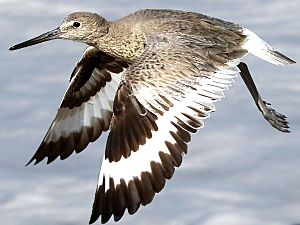Willet facts for kids
Quick facts for kids Willet |
|
|---|---|
 |
|
| Conservation status | |
| Scientific classification | |
| Subspecies | |
|
|
 |
|
| Synonyms | |
|
Scolopax semipalmatus |
The willet (Tringa semipalmata) is a large shorebird that lives near water. It belongs to the sandpiper family, called Scolopacidae. It's a strong, big sandpiper, and the largest bird in its group called "shanks" (genus Tringa). Its closest relative is the lesser yellowlegs, a smaller bird. Willets breed in North America and the West Indies. They spend their winters in warmer places like southern North America, Central America, the West Indies, and South America.
Contents
Willet Types and Where They Live
Scientists used to think the willet was in its own special group, Catoptrophorus. But now, studies show it fits better with other "shanks" in the Tringa group. Some experts even think the two main types of willets should be separate species. This is because they look, act, and live in different places. They also have different genes.
The two main types of willets are:
- T. s. inornata (the western willet): This type breeds in the Canadian Prairies and goes south to places like California and Colorado. In winter, they mostly live along the Pacific coasts, from the southern United States down to northern Chile. Some also spend winter on the Atlantic coast.
- T. s. semipalmata (the eastern willet): This type breeds along the Atlantic coast, from Newfoundland down to the Gulf of Mexico and the Caribbean Islands. They spend their winters in the West Indies and along the eastern coast of South America, as far south as Brazil and Argentina.
Willets are usually found in North and South America. It's very rare to see a willet in Europe. There have only been a few sightings in places like the Azores and Portugal.
What Willets Look Like

The willet is a strong, heavy shorebird. It looks a bit like a common redshank but is bigger than a greater yellowlegs. When it flies, it looks like a godwit. You can see black feathers on its wings that stand out against a wide white band. It also has white feathers on its back and a gray tail band.
When a willet is flying, you might also notice the black feathers under its wings. On the ground, you can tell a willet by its gray legs and its short, thick, straight beak.
Its body is gray on top and white underneath. It has a clear white area above its eyes and a thin white ring around them, making it look like it's wearing glasses.
When it's time to breed, the willet's upper body gets brown stripes. When they are not breeding, their feathers are plainer.
Measurements:
- Length: 13.0-16.1 inches (33-41 cm)
- Weight: 7.0-11.6 ounces (200-330 g)
- Wingspan: 27.6 inches (70 cm)
Willet Sounds
The willet's name comes from the sound it makes! It has a loud, sharp "pill-will-willet" call. This call is higher and faster for eastern willets than for western ones.
Willets make other sounds too. If a predator is nearby, breeding birds make a quick, sharp "kleep" sound. When non-breeding birds are alarmed, they might make a high-pitched "kip-kip-viek" or a "kreei" call. They also have a special "klay-dir" call when they fly over another willet's area. This call is also used to stay in touch when willets are migrating.
Willet Homes
The two types of willets live in different places when they are breeding. The eastern willet breeds in salt marshes along the coast. The western willet breeds in freshwater marshes, ponds, and other wet areas inland.
In winter, both types of willets move to coastal areas. You can find them on rocky or sandy beaches, as well as in mudflats and coastal marshes.
Willet Habits and Life
Willets are smart about how they find food. They walk steadily and pick up prey from the ground. They also use their sensitive beaks to probe into mud or sand. Sometimes, they even hunt bigger prey in shallow water.
On the coast, they love to eat small fiddler crabs and mole crabs. They also eat worms, clams, and other small creatures without backbones. Sometimes, they even eat plants! Willets also hunt fish and water insects in the water. They will wade deep into the water to catch them. Because their beaks are so sensitive, willets can hunt at night as well as during the day.
Willets protect their own areas, both where they breed and where they spend the winter. But they also form loose groups for breeding or wintering. When they want to show off, they hold their wings stiffly downwards when flying. On the ground, they show off the special pattern under their wings.
Willets are usually nervous birds. The ones closer to land in a saltmarsh are often the first to make alarm calls. This is similar to how the common redshank acts in Europe. However, some willets can be quite friendly. They often perch on rocks, trees, or fence posts.
Willet Reproduction
The male willet usually leads the female around their territory. He makes several small nest spots for her to choose from. The female then picks the best spot. The nest is a shallow dip in the ground, about 15 cm (6 inches) wide and 5 cm (2 inches) deep. The birds use their feet and chest to make it.
Western willets build their nests in grass close to the water. Eastern willets build theirs in saltmarshes or sand dunes. If the nest is in grass, the female might pull grass stalks over it to hide it. They might line the nest with fine grass leaves and small pebbles. If the nest is on bare ground, they might bring grass from far away to line it.
Male and female willets often stay together for a long time. They might return to the same breeding area year after year. The male protects their territory from other willets. He might walk along the edge of their area to challenge neighbors, which can sometimes lead to fights.
Both parents take turns sitting on the eggs for 22 to 29 days. The male usually incubates the eggs at night. The young willets can move around soon after hatching. The female leaves the territory before the young can fly, leaving the male to care for them for the last two weeks or so until they fledge.
Willet Conservation
Even though willets are still common in some areas, their numbers seem to have gone down since the 1960s. They are considered a species that could become threatened if we don't help them.
The western willet is at risk because grasslands are being turned into farms. Also, wetlands are being drained for agriculture. In California, their winter homes have been damaged by building near the coast. Willets can also be hurt by flying into power lines that cross their wetland breeding areas.
The Migratory Bird Treaty Act, passed in 1918, helped protect willets. Before this, hunters caught many willets for food. This law helped their numbers grow back to what they are today. There are about 250,000 willets in North America. About 150,000 are western willets, and 90,000 are eastern willets.
Images for kids
-
After catching a fish in Manuel Antonio National Park, Costa Rica
See also
 In Spanish: Playero aliblanco para niños
In Spanish: Playero aliblanco para niños









